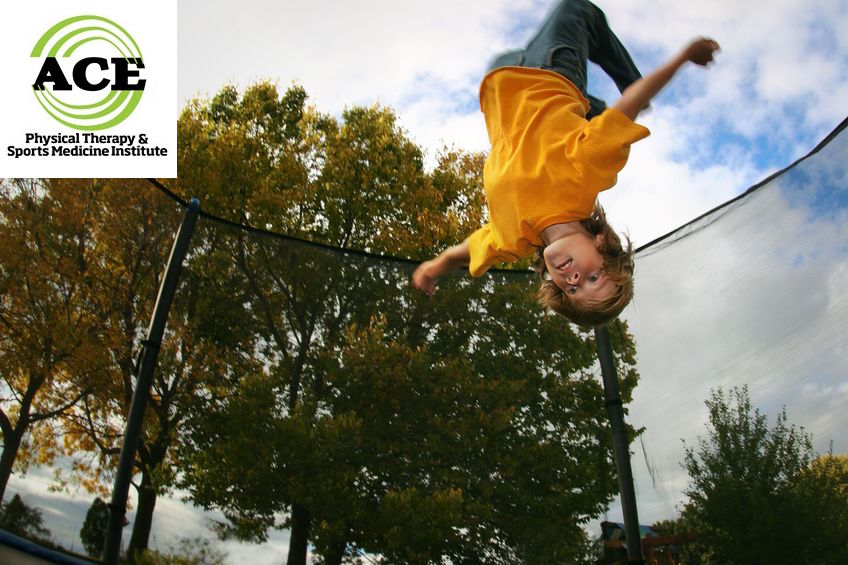TRAMPOLINE INJURIES

Tid Bits of Info
- More than 1 million trampoline-related injuries have been reported in the past 10 years.
- Many times the safety netting around the “back yard” trampoline is not installed properly and can lead to over-aggressive maneuvers.
- Nearly all fractures occurred in children under the age of 16 with average age of 9.5 years old.
- Males suffered more injuries and fractures than females.
- Seek the advice and treatment of a Physical Therapist if you suffer an injury that does not require surgery while using a trampoline.
Jumping on a trampoline provides hours of entertainment and can help to develop motor skills and coordination. Trampoline injuries can include cuts and scrapes, strains, fractures, concussions and even lifelong problems. Designed to train acrobats and pilots, the trampoline has come to play a key role in training various athletes. Used with the proper training and supervision, it can help improve coordination and skill development. Unfortunately, the lack of proper use and supervision has resulted in multiple injuries, particularly in children.
Trampoline injuries can range from a simple sprain to a severe fracture, incident rates have risen significantly in recent years. Trampoline parks and home usage often fail to provide proper training and supervision. Many injuries involve lower extremities and approximately 30% of those injuries are fractures. Although there are cases of severe neurologically involved injuries such as paralysis but these are rare and have been recorded to be less than 1% in the past 10 years.
A trampoline is not an effective baby-sitting solution for children. Most trampoline related fractures occur within children under the age of 16. These injuries often occur when two children jump on a trampoline at the same time. If the children are jumping and landing “out of sync,” the larger child can land and generate enough recoil force on the trampoline pad that literally “tosses” the smaller child off of the pad. Also, the if the smaller child is “landing” at the same time that the larger child has generated the increased “recoil” force the impact that occurs as the smaller child hits the trampoline pad can be so great that it causes a leg fracture.
There are two common types of fractures that occur in the children’s legs and both can cause a lifetime of trouble. Both of these fractures result of compression forces released by the impact that occurs when they land on the trampoline pad. Experts believe that children do not have the muscle strength to protect the bones and joints from the forceful impact that occurs when they hit the trampoline pad. The older children and athletes that use the trampoline as part of their regular workouts are stronger and their muscles are capable of providing dynamic support to their bones and joints.
The compressive fractures can occur in two primary areas. The top of the Tibia or shin bone can “collapse” on one side and is referred to as a Tibial Plateau fracture. These fractures need to be “fixed” surgically most times to make sure the joint is “level”. When the compression fracture occurs on one side, that side is lower than the opposite, non-involved side of the joint. This un-level status places excess force on the non-involved portion of the joint. If the joint is not “leveled” the joint is pre-disposed to arthritis. The second type of compressive fracture that commonly occurs in children involves the growth plate of the child’s ankle. This fracture has been termed “trampoline ankle” and can lead to growth arrest and future arthritic changes in the child’s ankle joint.
Injuries can occur when people use trampolines as entertainment or as a workout device, but proper supervision can help to reduce the frequency of occurrence. Making sure that children understand how to jump and land on the trampoline pad will be critical and trying to keep relatively equal size children on the same trampoline can reduce the injury rate and severity of injuries that do occur.
If you or your child suffers an injury that does not require surgery you can seek the advice and treatment directly from a Physical Therapist. These healthcare professionals are licensed and are experts at treating musculoskeletal injuries. If they evaluate you and think that you need to see an orthopaedic doctor for further diagnostic testing they can refer you to a proper doctor. You do not need a doctor’s referral to seek treatment from a Physical Therapist.
Trampolines can provide hours of entertainment for children and help to develop coordination and proper movement patterns in children and athletes. This apparatus can lead to injuries that can be severe, but if the proper supervision and precautions are taken prior to its use it can be more beneficial than harmful.


























I think this is one of those situations that physical therapists’ can really get their hands in when it comes to educating the population. Proper supervision can not be given without proper education of the severity of injuries that can occur from something that seems so innocent.